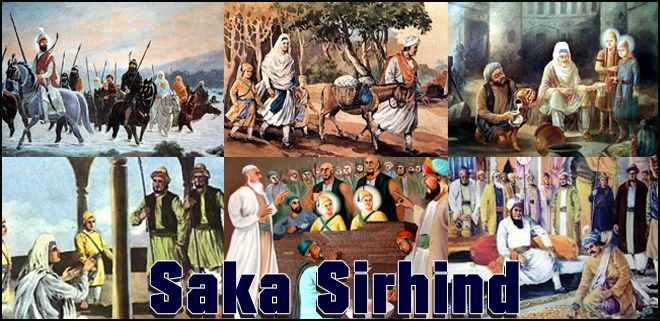Story of Undying Faith & Spirit (Saka Sirhind)

Shaheedi Jor Mela at Chamkaur Sahib
12/24/2015Sikh charity brings spirit of Christmas to London’s homeless
12/26/201526th December commemorates the Shaheedi divas (martyrdom day) of the younger Sahibzaadey (princes of Guru Gobind Singh ji), Baba Zoravar Singh (aged 7) and Baba Fateh Singh (aged 5), and the elderly mother of Guru Ji, Mata Gujjar Kaur Ji. In tribute to their shaheedi, a brief summary of their shaheedi and the great souls that risked their lives in doing their seva (service) is below.
[column size=one_half position=first ]
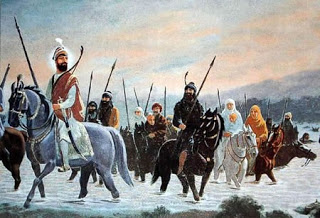 [/column][column size=one_half position=last ]
[/column][column size=one_half position=last ]
On the night of 5-6 December 1705, Guru Gobind Singh ji and all the Sikhs had to leave the Fort of Anandpur Sahib after the Mughals and Hindu hill kings made false oaths stating that they would not attack the Sikhs. During the evacuation Mata Gujri Kaur ji, who had been caring for the younger two Sahibzaadey (princes), escorted them to the River Sirsa. While crossing the River Sarsa on a mule, in the darkness of the night and rush, Mata Gujjar Kaur ji and the two younger Sahibzaadey were separated from Guru Gobind Singh ji and the rest of the family.
[/column]
[column size=one_half position=first ]
 [/column][column size=one_half position=last ]
[/column][column size=one_half position=last ]
After crossing the River Sirsa, Mata Gujjar Kaur ji and youngest Sahibzaadey spent a night in the hut of Bhai Kumma ji Maashki (boatman), known also as Kareema Mallaah. He used to be a Hindu and was known by the name Karma Jheevar. He was forcibly converted to Islam, but still practised Hindu religious rites. Mata ji’s mule had carried some important articles and ornaments. The Sikh accompanying them got separated from them due to floods and bad weather during darkness of night. Mata Gujjar Kaur ji stayed in his hut for two days. A Brahmin lady by the name of Bibi Lakshmi ji looked after them serving food and shelter.
[/column]
[column size=one_half position=first ]
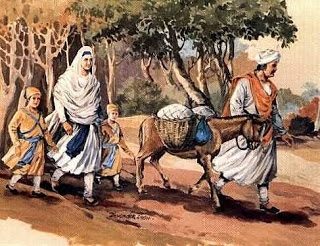 [/column][column size=one_half position=last ]
[/column][column size=one_half position=last ]
During this time Gangu Brahmin met them. Gangu used to be devotee of the Guru’s House for 16 years. According to Principal Satbir Singh he was called “Gangu Rasoeeyaa” because he had a bad temper and was always irritated. A rasoyee (kitchen) is always hot when food is cooked. Since Gangu was always in bad mood, some started calling him Gangu Rasoee i.e. Gangu the kitchen. From this some historians misinterpreted that he was a Rasoeeyaa (cook) in the Guru’s House. Gangu escorted Mata ji and the Sahibzaadey to his own house in the village of Kheri, now known as Saheri, near Morinda in present day Ropardistrict. While unsaddling the horse he saw that there was some gold coins in the saddlebag of Mata Gujri Kaur Ji. This tempted him to treachery and turning his back to Guru Sahib. He not only stole the saddlebag during the night, but also planned to betray the fugitives to the government in hope of a reward.
[/column]
[column size=one_half position=first ]
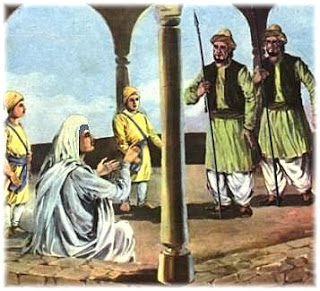 [/column][column size=one_half position=last ]
[/column][column size=one_half position=last ]
On the morning of 7th December 1705, the day of the fateful battle of Chamkaur Sahib, Baba Zorawar Singh ji, along with Baba Fateh Singh ji and their grandmother, were taken into custody by Jani Khan and Mani Khan Ranghar, the police official of Morinda. They were despatched on the following day to Sirhind where they were detained and kept in in the Cold Tower (Thandda Burj) of the Fort. Mata ji and the Sahibzaadey stayed in the top of the Cold Tower, where there were no four walls to guard them from the winter cold and chill of December. The young children had no extra clothes or blankets to protect them from the winter chill, other than the warmth of listening to Gurbaani and the huddling around their beloved grandmother.
[/column]
[column size=one_half position=first ]
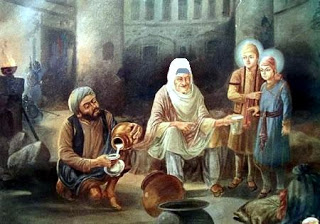 [/column][column size=one_half position=last ]
[/column][column size=one_half position=last ]
One of Wazir Khan’s kitchen staff was a Hindu man called Bhai Moti Raam ‘Mehra’ who was from Jheevar (waterman) family. His family had respect and devotion for Guru ji. Many Sikh travellers on their way to Anandpur Sahib used to take rest in his small hut. The Daroga (police chief) asked Bhai Moti Raam ji to serve food the prisoners. Bhai Moti Raam ji paid his respects to Mata ji and the Sahibzaadey and explained he had brought them food. Mata ji refused to eat the food. He fell at his feet and explained who he was. Mata ji calmly explained that she would not eat the food from the kitchen of evil people. The Daroga was informed and instead food was brought from the house of Sucha Nand (the Hindu courtier who hated Guru ji). Mata ji refused the food again. The Nawab became angry and gave orders that no one should co-operate with these prisoners and anyone helping them from now would be severely punished. Bhai Moti Raam ji discussed with his family that he would risk his life to ensure that Guru ji’s elderly mother and children do not hungry.
[/column]
[column size=one_half position=first ]
 [/column][column size=one_half position=last ]
[/column][column size=one_half position=last ]
Bhai Moti Raam ji milked his cow he had at home and filled a bowl and brought it to drink for Mata ji and the Sahibzaadey. Knowing that their would be high security around the Thandaa Burj he took whatever silver coins were available in his house in to his pocket to pay the guards. He assured Mata ji that as a sincere devotee of Guru ji he had brought the milk from his own home and from his own income. Mata ji and the Sahibzaadey happily drank the milk and thanked him for his seva (selfless service). This seva continued for number of days. Mata ji was so delighted, that she showered blessings on him. After the Sahibzaadey were martyred, another worker called Pamma found out about Bhai Moti Raam ji’s seva and reported it to Divaan Such Nand. Bhai Sahib was brought before Nawaab Wazir Khan and he was asked if he had served milk to Mata ji and the Sahibzaady. With high spirits, fearlessness and sincerity he replied, “I have nothing to hide. Yes! I have served milk to them. I have done no crime in feeding hungry people.” Bhai Moti Raam ji and his whole family (elderly mother, wife -Bibi Bholee ji, and baby son) were given the punishment of being crushed in in Kohlu (a wooden mill used to extract oil from seeds). (Note: this was time after the Sahibzaadey attained shaheedi).
[/column]
[column size=one_half position=first ]
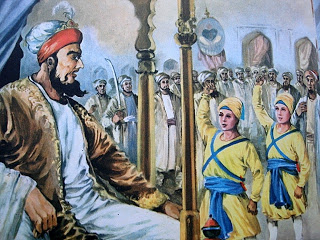 [/column][column size=one_half position=last ]
[/column][column size=one_half position=last ]
On 9th December 1705, Baba Zorawar Singh jee and Baba Fateh Singh jee were produced before the faujdaar, Nawaab Wazir Khan, who had just returned from Chamkaur Sahib with his feudal ally, Nawab Sher Muhammad Khan of Malerkotla. Wazir Khan tried to lure the Sahibzaadey to embrace Islam with promises of riches and honours, but they spurned the suggestion. He then threatened them with death, but they remained undaunted. Death sentence was finally pronounced. Upon Sher Muhammad Khan’s intercession for the innocent children to be spared their lives, they were given some more time to ponder over the suggestion to convert.
[/column]
[column size=one_half position=first ]
 [/column][column size=one_half position=last ]
[/column][column size=one_half position=last ]
Baba Zorawar Singh ji and his brother spent another two days of the severe winter in their old grandmother’s lap in the Cold Tower. Still adamant to live and die for the Sikh faith and to never turn their back to Guru Sahib, on 11th December 1705 a ‘fatwa’, religious edict, was issued for the Sahibzaadey to be bricked and sealed alive in a wall. According to Gur Bilaas Bhai Mani Singh, one of the oldest written records, Baba Zorawar Singh ji and Baba Fateh Singh ji were bricked alive, tortured by having their ligaments cut where it came in the way of the wall, and then suffocated in the sealed wall. The aged Mata Gujjar Kaur ji who had all along been kept in the Cold Tower, only a little distance away, breathed her last while joined in the Simran (remembrance) of Waheguru, as the news reached her ears.
[/column]
[column size=one_half position=first ]
 [/column][column size=one_half position=last ]
[/column][column size=one_half position=last ]
Seth Todar Mal ji, a wealthy merchant of Sirhind, risked his life by seeking permission for performing the cremation of the three dead bodies of the great shaheeds (martrys) the following day. With Mata Gujjar Kaur ji and the Sahibzaadey (aged 5 and 7) shaheed (martyred) the despicable Mughal authorities refused their funeral rites on government land, it was decreed that there funeral rites could only be performed on land bought from Chaudhari Atta. Not only this, but the land could only be bought by laying gold coins (ashrifs) on the required area, vertically. Bhai Todar Mall ji did not shun his responsibility and laid down the required coins and made arrangements for the cremations and paid the heavy sum of 78,000 gold coins. His wife gave all her jewellery and ornaments to be sold for the cause. Maybe he had to also beg and borrow to raise the total amount, who knows, but the fact remains this was truly a noble deed. Bhai Todar Mal ji and his wife forsaked everything for his love of Guru ji, which is the reason why Sikhs hold Divaan Todar Mal ji in such high esteem. Bhai Todar Mal ji with the help of Bhai Moti Raam ji collected fire wood and cremated the three bodies.
[/column]
[column size=one_half position=first ]
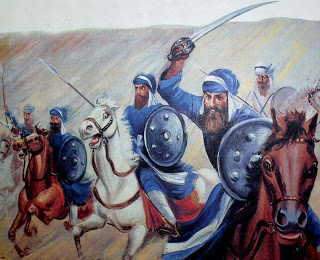 [/column][column size=one_half position=last ]
[/column][column size=one_half position=last ]
In 1710, Baba Banda Singh Bahadur ji conquered Sirhind and searched punished those responsible for committing atrocities. The murderers of the Sahibzaadey and Bhai Moti Raam ji’s family were punished. Sucha Nand was beaten, had a bull’s ring put in his nose and made to beg from house to house from the people he had robbed over so many years. He was later killed. Nawaab Wazir Khan was killed and his body was tied to a donkey and dragged across all of the Sirhind. Baba ji also searched for loyal people who tried to help Guru jee and done seva of Mata ji and the Sahibzaade. Bhai Kareem (the boatman), who later took Amrit and became Bhai Karam Singh ji, and Bibi Lakshmi ji (from a Brahmin family) were honoured by the Khalsa and given thanks.
[/column]

